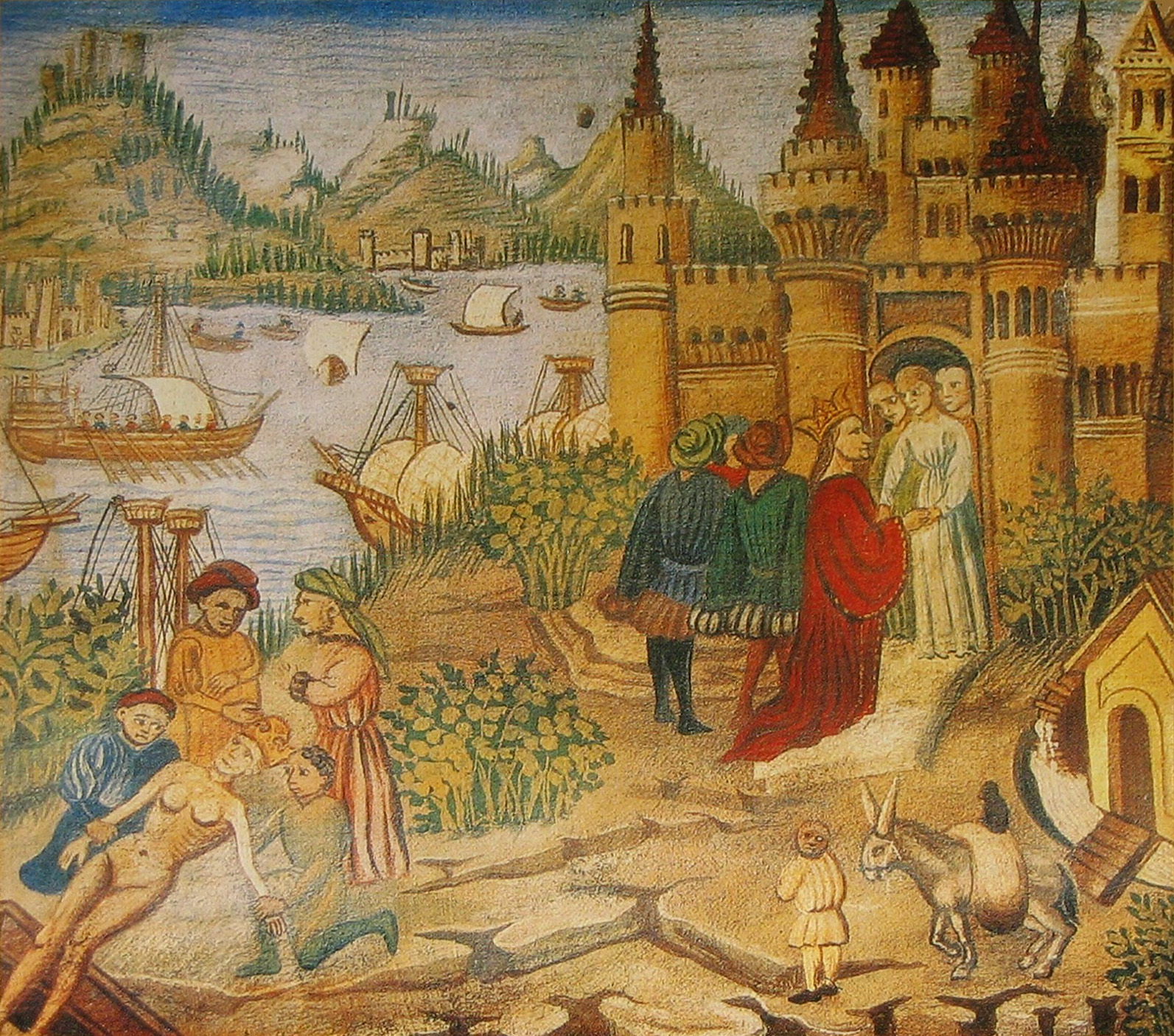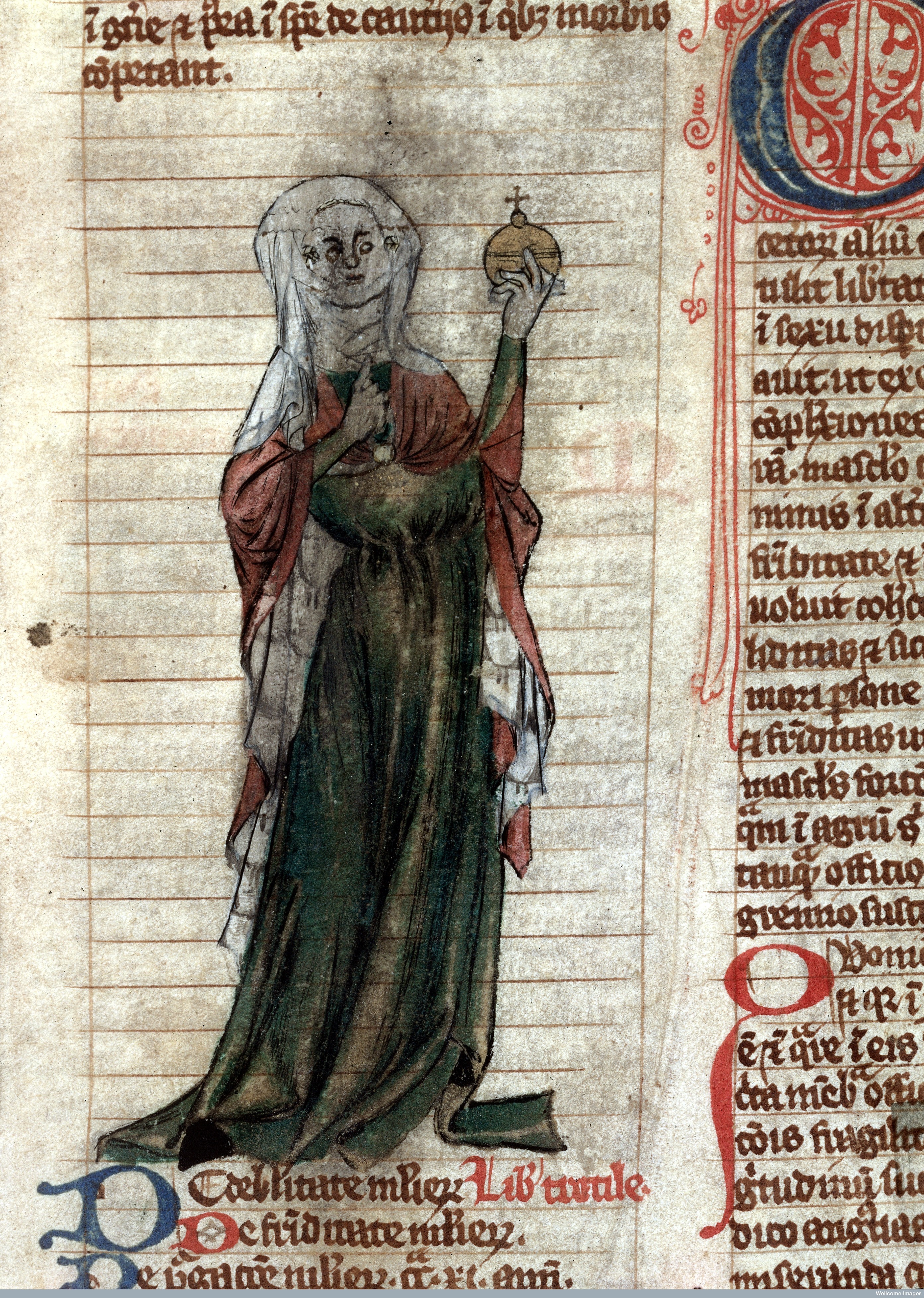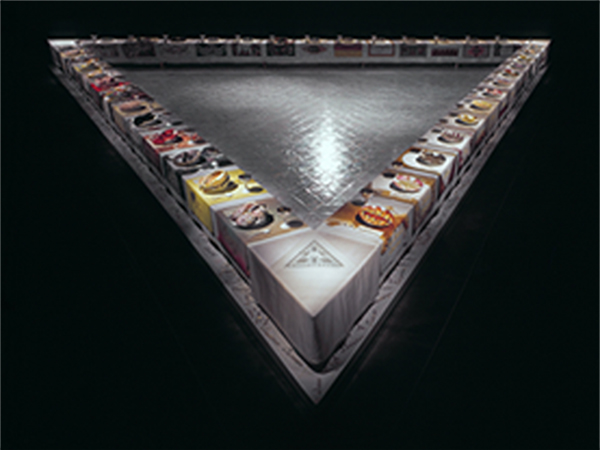|
Abella
Abella, often known as Abella of Salerno or Abella of Castellomata, was a physician in the mid fourteenth century. Abella studied and taught at the Salerno School of Medicine. Abella is believed to have been born around 1380, but the exact time of her birth and death is unclear. Abella lectured on standard medical practices, bile, and women's health and nature at the medical school in Salerno. Abella, along with Rebecca de Guarna, specialized in the area of embryology. She published two treatises: De atrabile (On Black Bile) and De natura seminis humani (on the Nature of the Seminal Fluid), neither of which survive today. In Salvatore De Renzi's nineteenth-century study of the Salerno School of Medicine, Abella is one of four women (along with Rebecca de Guarna, Mercuriade, and Constance Calenda) mentioned who were known to practice medicine, lecture on medicine, and wrote treatises. These attributes placed Abella into a group of women known as the Mulieres Salernitanae, or women ... [...More Info...] [...Related Items...] OR: [Wikipedia] [Google] [Baidu] |
Salerno School Of Medicine
The Schola Medica Salernitana ( it, Scuola Medica Salernitana) was a Medieval medical school, the first and most important of its kind. Situated on the Tyrrhenian Sea in the south Italian city of Salerno, it was founded in the 9th century and rose to prominence in the 10th century, becoming the most important source of medical knowledge in Western Europe at the time. Arabic medical treatises, both those that were translations of Greek texts and those that were originally written in Arabic, had accumulated in the library of Montecassino, where they were translated into Latin; thus the received lore of Hippocrates, Galen and Dioscorides was supplemented and invigorated by Arabic medical practice, known from contacts with Sicily and North Africa. As a result, the medical practitioners of Salerno, both men and women, were unrivaled in the medieval Western Mediterranean for practical concerns. Overview Founded in the 9th century, the school was originally based in the dispensary of a ... [...More Info...] [...Related Items...] OR: [Wikipedia] [Google] [Baidu] |
Mercuriade
Mercuriade (14th-century) was an Italian physician, surgeon and medical author. She is one of the few woman physicians known from the Middle Ages. Mercuriade was a student of the University of Salerno and belonged to the minority of female students of her time period. She was the author of the treaties ''De Febre Pestilenti'' (on Crisis in Pestilent Fever), ''De Curatio'' (The Cure of Wounds) and ''De Ungentis'' (on Ungentis). Her work was included in the ''Collectio Salernitana''. She is considered one of the " ladies of Salerno" along with Abella Abella, often known as Abella of Salerno or Abella of Castellomata, was a physician in the mid fourteenth century. Abella studied and taught at the Salerno School of Medicine. Abella is believed to have been born around 1380, but the exact time o ..., Rebecca Guarna, and Francesca de Romana who attended the medical school in Salerno from its beginning and helped usher in a "'medical renaissance'" in Europe. References Extern ... [...More Info...] [...Related Items...] OR: [Wikipedia] [Google] [Baidu] |
Francesca Of Salerno
''Trotula'' is a name referring to a group of three texts on women's medicine that were composed in the southern Italian port town of Salerno in the 12th century. The name derives from a historic female figure, Trota of Salerno, a physician and medical writer who was associated with one of the three texts. However, "Trotula" came to be understood as a real person in the Middle Ages and because the so-called ''Trotula'' texts circulated widely throughout medieval Europe, from Spain to Poland, and Sicily to Ireland, "Trotula" has historic importance in "her" own right. The ''Trotula'' texts: genesis and authorship In the 12th century, the southern Italian port town of Salerno was widely reputed as "the most important center for the introduction of Arabic medicine into Western Europe". In referring to the School of Salerno in the 12th century, historians actually mean an informal community of masters and pupils who, over the course of the 12th century, developed more or less formal ... [...More Info...] [...Related Items...] OR: [Wikipedia] [Google] [Baidu] |
Embryology
Embryology (from Greek ἔμβρυον, ''embryon'', "the unborn, embryo"; and -λογία, ''-logia'') is the branch of animal biology that studies the prenatal development of gametes (sex cells), fertilization, and development of embryos and fetuses. Additionally, embryology encompasses the study of congenital disorders that occur before birth, known as teratology. Early embryology was proposed by Marcello Malpighi, and known as preformationism, the theory that organisms develop from pre-existing miniature versions of themselves. Aristotle proposed the theory that is now accepted, epigenesis. Epigenesis is the idea that organisms develop from seed or egg in a sequence of steps. Modern embryology, developed from the work of Karl Ernst von Baer, though accurate observations had been made in Italy by anatomists such as Aldrovandi and Leonardo da Vinci in the Renaissance. Comparative embryology Preformationism and epigenesis As recently as the 18th century, the pre ... [...More Info...] [...Related Items...] OR: [Wikipedia] [Google] [Baidu] |
Constance Calenda
Constance Calenda ( it, Costanza or ; ) was an Italian surgeon specializing in diseases of the eye.Walsh JJ. 'Medieval Women Physicians' in ''Old Time Makers of Medicine: The Story of the Students and Teachers of the Sciences Related to Medicine During the Middle Ages'', ch. 8, (Fordham University Press; 1911) (accessed 22 August 2007) She studied at the University of Salerno
The University of Salerno ( it, Università degli Stu ...
[...More Info...] [...Related Items...] OR: [Wikipedia] [Google] [Baidu] |
Judy Chicago
Judy Chicago (born Judith Sylvia Cohen; July 20, 1939) is an American feminist artist, art educator, and writer known for her large collaborative art installation pieces about birth and creation images, which examine the role of women in history and culture. During the 1970s, Chicago founded the first feminist art program in the United States at California State University, Fresno (formerly Fresno State College) and acted as a catalyst for feminist art and art education. Her inclusion in hundreds of publications in various areas of the world showcases her influence in the worldwide art community. Additionally, many of her books have been published in other countries, making her work more accessible to international readers. Chicago's work incorporates a variety of artistic skills, such as needlework, counterbalanced with skills such as welding and pyrotechnics. Chicago's most well known work is "The Dinner Party", which is permanently installed in the Elizabeth A. Sackler Center f ... [...More Info...] [...Related Items...] OR: [Wikipedia] [Google] [Baidu] |
The Dinner Party
''The Dinner Party'' is an installation artwork by feminist artist Judy Chicago. Widely regarded as the first epic feminist artwork, it functions as a symbolic history of women in civilization. There are 39 elaborate place settings on a triangular table for 39 mythical and historical famous women. Sacajawea, Sojourner Truth, Eleanor of Aquitaine, Empress Theodora of Byzantium, Virginia Woolf, Susan B. Anthony, and Georgia O'Keeffe are among the symbolic guests. Each place setting includes a hand-painted china plate, ceramic cutlery and chalice, and a napkin with an embroidered gold edge. Each plate, except the ones corresponding to Sojourner Truth and Ethel Smyth, depicts a brightly colored, elaborately styled vulvar form. The settings rest on intricately embroidered runners, executed in a variety of needlework styles and techniques. The table stands on ''The Heritage Floor'', made up of more than 2,000 white luster-glazed triangular tiles, each inscribed in gold scripts wi ... [...More Info...] [...Related Items...] OR: [Wikipedia] [Google] [Baidu] |
Rebecca De Guarna
Rebecca Guarna (fl. 1200), was an Italian physician and surgeon and author. She is one of a number of female physicians known from the Middle Ages. She was one of the women known as the " ladies of Salerno". Rebecca Guarna was a member of the same Salernitan family as the famous Romuald Guarna, priest, physician and historian. She studied at the University of Salerno The University of Salerno ( it, Università degli Studi di Salerno, UNISA) is a university located in Fisciano and in Baronissi, Italy. Its main campus is located in Fisciano while the Faculty of Medicine is located in Baronissi. It is organize ... and belonged to the minority of female students of her time period. She was the author of ''De Urinis'' (on Urine), ''De febrius'' (on Fever) and ''De embrione'' (on the embryo): her treatise De Urinis treated the method of diagnosing illness by urine sample.L. Whaley: Women and the Practice of Medical Care in Early Modern Europe, 1400-1800' References Further readin ... [...More Info...] [...Related Items...] OR: [Wikipedia] [Google] [Baidu] |
Trota Of Salerno
Trota of Salerno (also spelled Trocta) was the world's first gynecologist. She was a medical practitioner and writer in the southern Italian coastal town of Salerno who lived in the early or middle decades of the 12th century. Her fame spread as far as France and England in the 12th and 13th centuries. A Latin text that gathered some of her therapies (and recounted a cure she had performed) was incorporated into an ensemble of treatises on women's medicine that came to be known as the ''Trotula'', "the little book alled'Trotula'". Gradually, readers became unaware that this was the work of three different authors. They were also unconscious of name of the historical writer, which was "Trota" and not "Trotula". The latter was thenceforth misunderstood as the author of the whole compendium. These misconceptions about the author of ''Trotula'' contributed to the erasure or modification of her name, gender, level of education, medical knowledge, or the time period in which the texts w ... [...More Info...] [...Related Items...] OR: [Wikipedia] [Google] [Baidu] |
Maria Incarnata
Maria may refer to: People * Mary, mother of Jesus * Maria (given name), a popular given name in many languages Place names Extraterrestrial *170 Maria, a Main belt S-type asteroid discovered in 1877 *Lunar maria (plural of ''mare''), large, dark basaltic plains on Earth's Moon Terrestrial *Maria, Maevatanana, Madagascar *Maria, Quebec, Canada *Maria, Siquijor, the Philippines *María, Spain, in Andalusia *Îles Maria, French Polynesia *María de Huerva, Aragon, Spain *Villa Maria (other) Arts, entertainment, and media Films * ''Maria'' (1947 film), Swedish film * ''Maria'' (1975 film), Swedish film * ''Maria'' (2003 film), Romanian film * ''Maria'' (2019 film), Filipino film * ''Maria'' (2021 film), Canadian film directed by Alec Pronovost * ''Maria'' (Sinhala film), Sri Lankan upcoming film Literature * ''María'' (novel), an 1867 novel by Jorge Isaacs * ''Maria'' (Ukrainian novel), a 1934 novel by the Ukrainian writer Ulas Samchuk * ''Maria'' (play), a 1935 play b ... [...More Info...] [...Related Items...] OR: [Wikipedia] [Google] [Baidu] |
Salerno
Salerno (, , ; nap, label= Salernitano, Saliernë, ) is an ancient city and ''comune'' in Campania (southwestern Italy) and is the capital of the namesake province, being the second largest city in the region by number of inhabitants, after Naples. It is located on the Gulf of Salerno on the Tyrrhenian Sea. In recent history the city hosted Victor Emmanuel III, the King of Italy, who moved from Rome in 1943 after Italy negotiated a peace with the Allies in World War II, making Salerno the capital of the "Government of the South" (''Regno del Sud'') and therefore provisional government seat for six months. Some of the Allied landings during Operation Avalanche (the invasion of Italy) occurred near Salerno. Human settlement at Salerno has a rich and vibrant past, dating back to pre-historic times. In the early Middle Ages it was an independent Lombard principality, the Principality of Salerno, which around the 11th century comprised most of Southern Italy. During this time ... [...More Info...] [...Related Items...] OR: [Wikipedia] [Google] [Baidu] |




